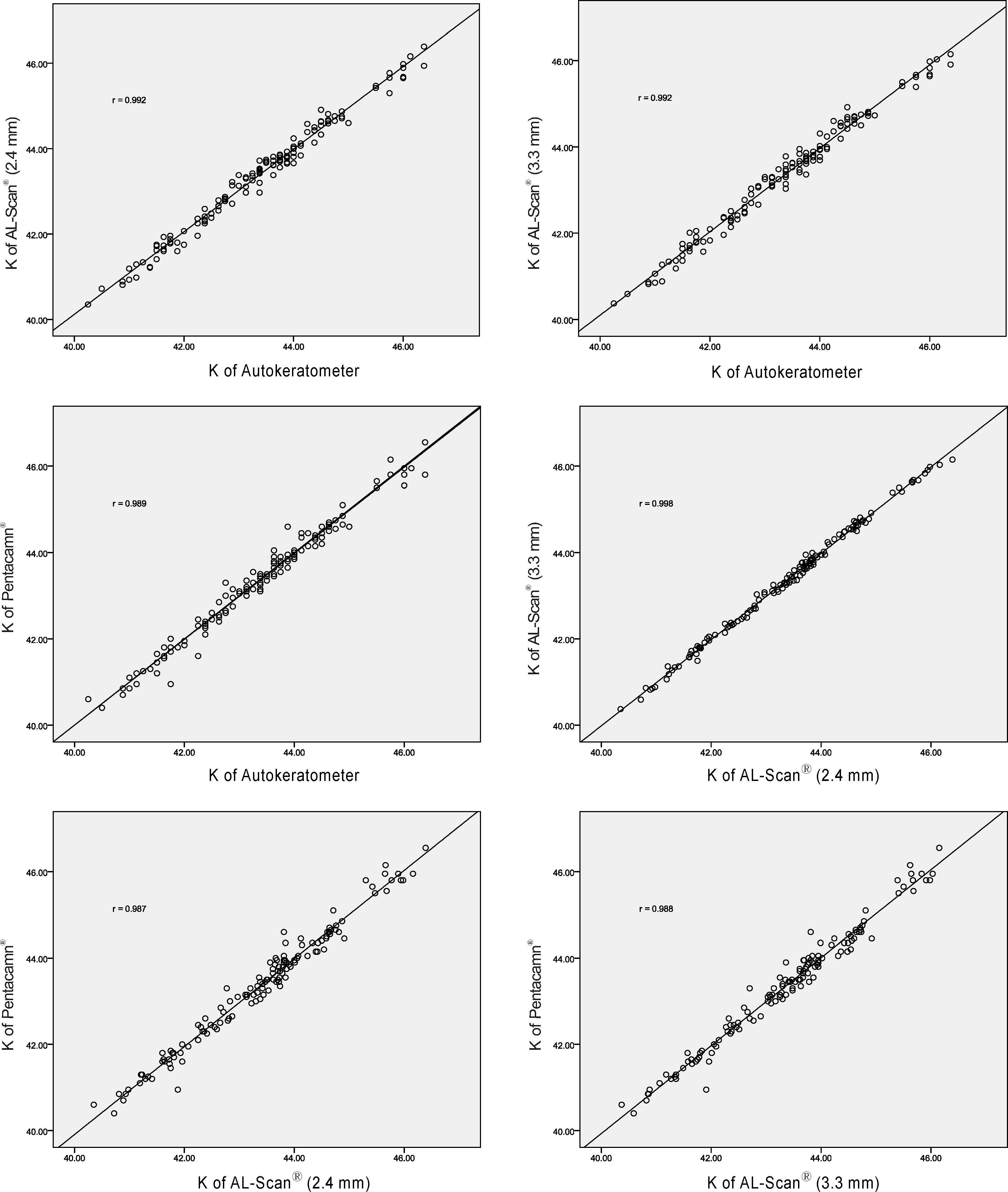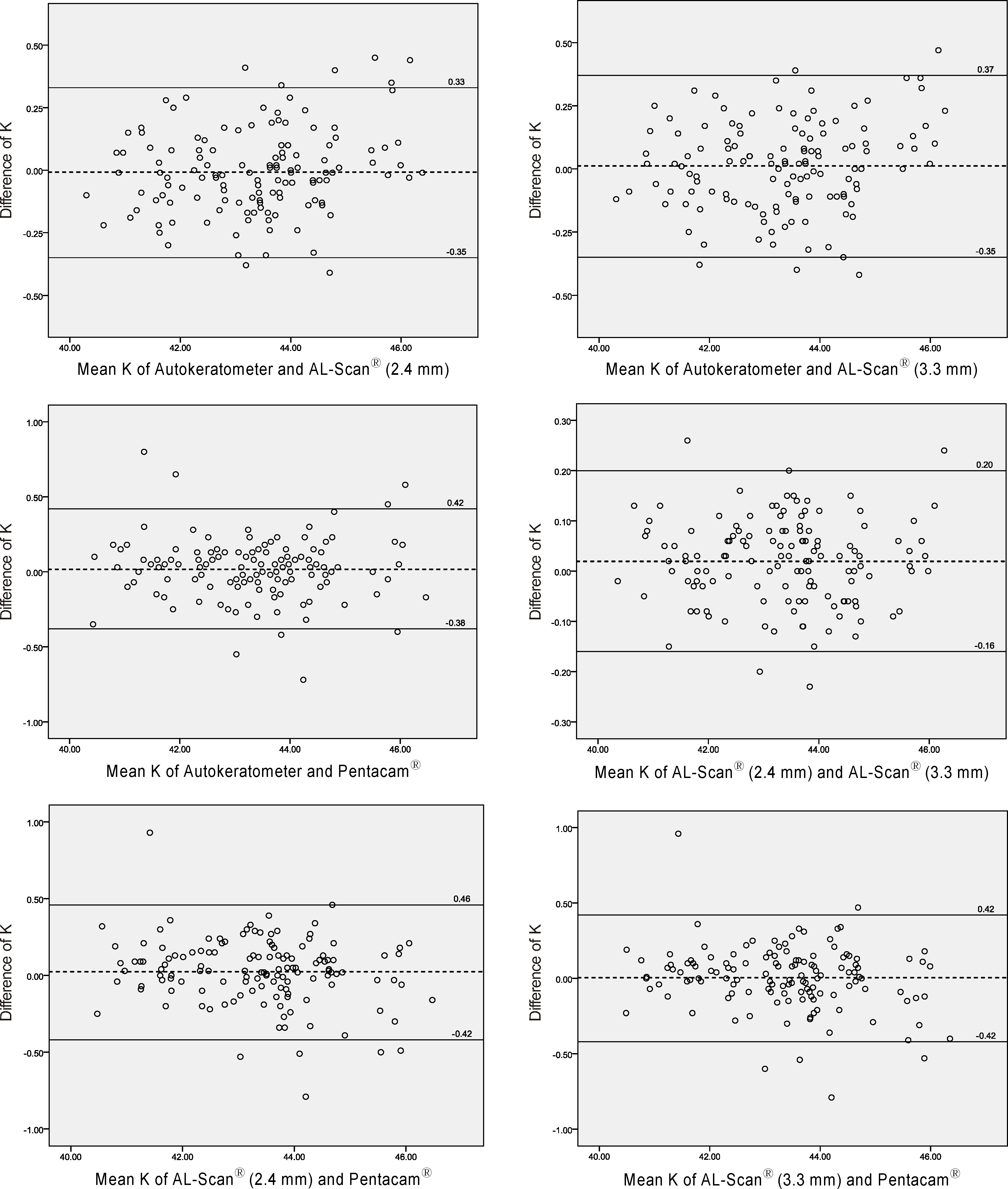Abstract
Purpose
To investigate clinical availability of AL-Scan® (Nidek, Gamagori, Japan) by comparing corneal refractive power with AL-Scan™, Autokeratometer™ (Topcon KR-1, Tokyo, Japan) and Pentacam™ (Oculus, Wetzlar, Germany) devices.
Methods
Seventy-one patients (142 eyes) who visited our hospital for refractive surgery were tested using AL-Scan®, Autokeratometer and Pentacam® and corneal refractive power was compared among devices.
Results
When comparing measurements with AL-Scan®, Autokeratometer and Pentacam®, the mean corneal refractive power was 43.37 ± 1.32 D (2.4 mm zone), 43.35 ± 1.32 D (3.3 mm zone), 43.36 ± 1.35 D, and 43.35 ± 1.36 D respectively and showed no significant differences. Corneal refractive power had strongly positive linear correlation (p < 0.001) and Bland-Altman plots showed high degree of agreement among AL-Scan®, Autokeratometer and Pentacam® devices.
Conclusions
Because measuring ocular biometry with AL-Scan including axial length, intraocular lens power calculation and topography simultaneously is possible, clinical use is convenient. Corneal refractive power was not different when compared with autokeratometer and Pentacam® devices, thus, AL-Scan® can be used in the clinical environment.
Go to : 
References
1. Koranyi G, Lydahl E, Norrby S, Taube M. Anterior chamber depth measurement: a-scan versus optical methods. J Cataract Refract Surg. 2002; 28:243–7.

2. Maeng HS, Ryu EH, Chung TY, Chung ES. Effects of anterior chamber depth and axial length on refractive error after intraocular lens implantation. J Korean Ophthalmol Soc. 2010; 51:195–202.

3. Norrby S. Sources of error in intraocular lens power calculation. J Cataract Refract Surg. 2008; 34:368–76.

4. Olsen T. Prediction of the effective postoperative (intraocular lens) anterior chamber depth. J Cataract Refract Surg. 2006; 32:419–24.

5. Qazi MA, Cua IY, Roberts CJ, Pepose JS. Determining corneal power using Orbscan II videokeratography for intraocular lens calculation after excimer laser surgery for myopia. J Cataract Refract Surg. 2007; 33:21–30.

6. Rufer F, Schroder A, Arvani MK, Erb C. Central and peripheral corneal pachymetry–standard evaluation with the Pentacam system. Klin Monbl Augenheilkd. 2005; 222:117–22.
7. Lee DM, Ahn JM, Seo KY, et al. Comparison of corneal measurement values between two types of topography. J Korean Ophthalmol Soc. 2012; 53:1584–90.

8. Kim SI, Kang SJ, Oh TH, et al. Accuracy of ocular biometry and postoperative refraction in cataract patients with AL-Scan(R). J Korean Ophthalmol Soc. 2013; 54:1688–93.
9. Holladay JT, Prager TC, Ruiz RS, et al. Improving the predictability of intraocular lens power calculations. Arch Ophthalmol. 1986; 104:539–41.

10. Mamalis N. Complications of foldable intraocular lenses requiring explanation or secondary intervention–1998 survey. J Cataract Refract Surg. 2000; 26:766–72.
11. Jo DH, Oh JY, Kim MK, et al. Corneal power estimation using Orbscan II videokeratography in eyes with previous corneal refractive surgeries. J Korean Ophthalmol Soc. 2009; 50:1730–4.

12. Findl O, Drexler W, Menapace R, et al. Improved prediction of intraocular lens power using partial coherence interferometry. J Cataract Refract Surg. 2001; 27:861–7.

13. Speicher L. Intra-ocular lens calculation status after corneal refractive surgery. Curr Opin Ophthalmol. 2001; 12:17–29.

14. Rosa N, Lanza M, Borrelli M, et al. Comparison of central corneal thickness measured with Orbscan and Pentacam. J Refract Surg. 2007; 23:895–9.

15. Butcher JM, O'Brien C. The reproducibility of biometry and keratometry measurements. Eye. 1991; 5:708–11.

16. Karabatsas CH, Cook SD, Papaefthymiou J, et al. Clinical evaluation of keratometry and computerised videokeratography: intraobserver and interobserver variability on normal and astigmatic corneas. Br J Ophthalmol. 1998; 82:637–42.

17. Han JM, Choi HJ, Kim MK, et al. Comparative analysis of corneal refraction and astigmatism measured with autokeratometer, IOL Master, and topography. J Korean Ophthalmol Soc. 2011; 52:1427–33.

18. Kim S, Chung SK. Comparison of corneal curvatures obtained with different devices. J Korean Ophthalmol. 2012; 53:618–25.

19. Savini G, Carbonelli M, Sbreglia A, et al. Comparison of anterior segment measurements by 3 Scheimpflug tomographers and 1 Placido corneal topographer. J Cataract Refract Surg. 2011; 37:1679–85.

20. Kawamorita T, Uozato H, Kamiya K, et al. Repeatability, reproducibility, and agreement characteristics of rotating Scheimpflug photography and scanning-slit corneal topography for corneal power measurement. J Cataract Refract Surg. 2009; 35:127–33.

21. Jain R, Dilraj G, Grewal SP. Repeatability of corneal parameters with Pentacam after laser in situ keratomileusis. Indian J Ophthalmol. 2007; 55:341–7.
Go to : 
 | Figure 1.Pearson correlation of corneal refractive power (K) measured with AL-Scan®, Autokeratometer and Pentacam®. |
 | Figure 2.Bland-Altman plots of corneal refractive power (K) measured with AL-Scan®, Autokeratometer and Pentacam®. |
Table 1.
Results of corneal refractive power (K) of AL-Scan®, Autokeratometer and Pentacam®
| Corneal refractive power (K) |
AL-Scan® |
Autokeratometer | Pentacam® | |
|---|---|---|---|---|
| 2.4 mm | 3.0 mm | 3.0 mm | 3.0 mm | |
| Kmean (diopter) | 43.37 ± 1.32 | 43.35 ± 1.32 | 43.36 ± 1.35* | 43.35 ± 1.36* |
| K1 (diopter) | 42.70 ± 1.20 | 42.69 ± 1.21 | 42.72 ± 1.23* | 42.63 ± 1.24* |
| K2 (diopter) | 44.04 ± 1.52 | 44.01 ± 1.52 | 44.00 ± 1.56* | 44.06 ± 1.58* |




 PDF
PDF ePub
ePub Citation
Citation Print
Print


 XML Download
XML Download